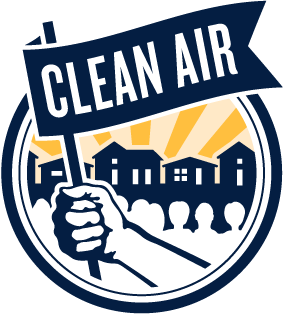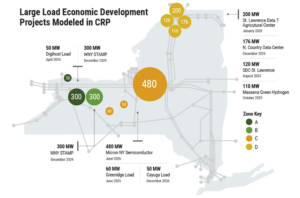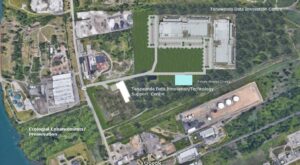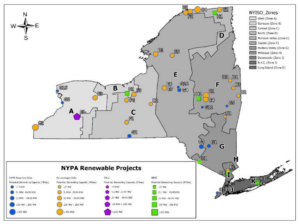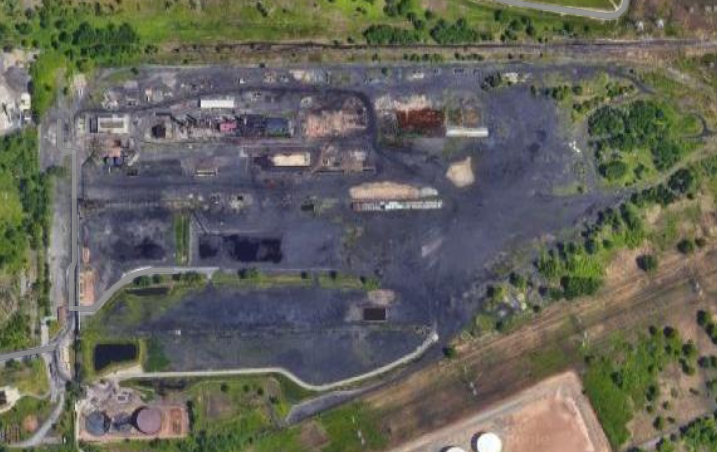Take Action Today – Demand Goodyear Corporation Rein in Ortho-toluidine Emissions!
Clean Air is working in coalition with Niagara Falls organizations, residents, and workers to support organizing efforts to force Goodyear Corporation to stop emitting ortho-toluidine, a bladder cancer causing chemical.
A community meeting in Niagara Falls related to the emissions from Goodyear will be held the first full week of January 2025 – stay tuned for details.
There is a LOT to this story – for specifics related to the Goodyear facility in particular, we highly recommend reading Jim Morris’ “The Cancer Factory” as well as the following recent articles.
- WBFO/Public Health Watch: “A dangerous carcinogen is in Niagara Falls’ air. The state hasn’t put a stop to it“
- Inside Climate News: “Computer Modeling Shows Carcinogen From Goodyear Plant Is Invading Niagara Falls Neighborhoods“
In summary, though, these are the key points to understand, via Don’t Waste New York, a statewide environmental justice organization we are working in coalition with:
- THE PROBLEM: In September 2024, the NYS Department of Environmental Conservation (DEC) made a map of the community around the Goodyear plant on 56th Street in Niagara Falls showing a cloud of toxic chemical emissions.
The chemical – Ortho toluidine or OT – causes bladder cancer. Since 1989, studies have found a significant number of cases of bladder cancer among the workers at Goodyear.
DEC and DOH have violated the public’s trust. They have not informed the community of the illegal toxic pollution. They have not enforced the law. They have not protected the health of community residents. - THE SOLUTION: The federal Environmental Protection Agency (EPA) has the legal power to issue a Clean Air Act Emergency Order (Section 303 of CAA) to immediately require Goodyear to reduce its toxic emissions.
Don’t Waste New York, a statewide community support group, sent EPA a request to issue an Emergency Order on November 27, 2024. Emergency Orders can be issued when a pollution problem poses an “imminent and substantial endangerment to the public health.
We also feel that the emissions from this facility are a key example of the overarching issues in Western New York related to environmental permits for industrial facilities – from expired Title Vs to State Air Facility permits without any expiration date to facilities operating on unissued draft permits, we have seen example after example of health and safety issues arising in environmental justice communities that would be addressed with sufficient oversight and enforcement actions. Just in this past couple of weeks, The Buffalo News featured further coverage related to this problem, honing in on how stack testing (ie, testing of filters in the air stacks at facilities) is tied to permit reviews, and how delayed permit renewals mean these tests are not conducted in regular frequency.
Stay tuned for further related actions!
Join Clean Air to hold the line on pollution in our communities and build power during a second Trump term.
Clean Air is a 501C3 Nonprofit organization so we do not and cannot endorse or promote those running for office. However, we can and will describe how an elected candidate’s policies or actions will affect the health and well being of working class people in WNY, and the conditions of the environment we are a part of.
Let us be clear, a second Donald Trump term is a direct and grave danger to the future ability to protect residents from pollution.
During Trump’s first term, he suspended pollution enforcement on permitted factories and facilities, and Clean Air stepped up and organized with others resulting in the NYS Attorney General joining a Lawsuit against the EPA which forced facilities to comply. All evidence points to an even greater attack on long standing popular bipartisan protections such as the Clean Air and Clean Water Acts, this time with a more radical partisan Supreme Court having the final say.
Clean Air’s organizing efforts are going to be an essential safeguard during a second Trump term to hold the line on environmental protections locally and across New York State. We are also going to have to organize with each other to create local resilience to blizzards, storms and flooding and extreme heat as federal assistance to help us prepare is likely to be slashed.
In times of crisis, it is our communities that have united to support one another, and Clean Air’s membership program provides a space for everyone to come together in our shared fight for environmental justice.
Become a member today by making a membership contribution and help us fund this fight.
Through this, you can help fund true grassroots organizing efforts to ensure we keep us safe during what is certain to be a chaotic time. Clean Air members and supporters are also welcome to attend our Happy Hour mixer on November 20 where we will be celebrating what we have done and reflecting on the crucial work ahead.
Without federal safeguards, we will need to turn our attention in the short term to state level actions – we know we can affect positive change here, because we have already, and we will do so again in the next four years.
With that in mind, we are also asking you to join us tomorrow November 7 at 6pm in Lewiston at the NYPA Power Vista at 5777 Lewiston Road, just off the Niagara University Campus. Clean Air is coordinating carpools from downtown Buffalo and Niagara Falls.
NYPA is currently accepting comments on a draft plan to build publicly-owned renewable energy projects, but the current draft falls far short of what is needed, especially given the regulatory environment we are going to be entering starting in 2025. Please join us – click here to register for the carpools.
If you are unable to make it, you can also send a comment using this form we launched on Monday. All comments will be due in January.
With determination,
Chris
October/November 2024 Monthly Updates – Fright for your rights – NYPA Hearing November 7!
Click here to subscribe to our monthly e-newsletter, and view this month’s edition by clicking the “Read More” link below.
We want renewable power, not data centers, at Tonawanda Coke!
Join us at NYPA’s Public Hearing on November 7 at at 6pm at the NYPA Power Vista at 5777 Lewiston Road in Lewiston NY! Carpools from Buffalo available.
NY is off track from our goals for a just transition off of fossil fuel-based energy onto renewables.
In part, this is due to the rise in data centers like those used for cryptocurrency mining, which is causing serious concerns about overall grid stability. Per the New York Independent System Operator, well over 500 MW of industrial power is currently modeled as expected demands on our power grid in coming years just from cryptocurrency mining operations at data centers.
In WNY, cryptocurrency mining operations have popped up in industrial corridors numerous times, most notably in Niagara Falls, where data centers caused such a nuisance that it spurred the city to develop a novel High Energy Use District zoning overlay, and North Tonawanda, where residents have been supported by Clean Air in their opposition to Digihost’s operations at the Fortistar gas-fired power plant for several years.
Cryptocurrency mining causes local environmental injustice concerns, most notably significant noise pollution and brownouts of the energy grid in environmental justice communities due to the extremely high energy demands.
The site owner for several of the cryptocurrency mining projects in Buffalo and Niagara Falls is Jon Williams, a brownfield developer who is also the current owner and developer for the former American Axle and Tonawanda Coke sites. American Axle, in addition to other operations, houses another Digihost mine, which pulls 42 Megawatts from the energy grid. Williams was, for a short time, a board member of Digihost, further cementing his direct connections with that company in particular, but he also has close ties to other firms, like US Bitcoin.
The stated desired site reuse for Tonawanda Coke primarily consists of a series of data centers – which, given Williams presence in the local cryptocurrency mining ecosystem, we should assume will mean cryptocurrency mining.
Residents who live adjacent to Tonawanda Coke, while grateful the stacks are down and that the site is being remediated, have strongly voiced opposition to cryptocurrency mining at TCC, and have expressed that they would prefer a more passive and generative use, like solar power generation.
Which brings us to our ask of our larger membership and the larger WNY community – please join us on November 7 at 6pm at the NYPA Power Vista at 5777 Lewiston Road in Lewiston. Register today to help us coordinate carpools.
For background – in 2023, NY passed the Build Public Renewables Act, which directs the New York Power Authority to plan, construct, and operate renewable energy projects in service of the state’s renewable energy goals. This is a groundbreaking and crucial piece of legislation, and Clean Air supported it’s passage.
With this new expanded authority and onus on NYPA to take action to develop renewable energy projects, NYPA then set to work to develop a plan, and on October 8 NYPA released the draft.
However, this plan falls far short – the plan is projected to develop 3.5 GW of renewable energy with a mix of private and public sector projects by 2030, which is multitudes short of what we need.
While it’s unclear where projects in NYISO Zone A are exactly proposed (see pages 36-47), what we can discern is that these projects do not appear to be primarily located on any of the numerous contaminated industrial brownfield sites in our region, which is a massive oversight and missed opportunity.
While much of the opposition to renewable energy development in our region stems from cynical self-serving interests like oil and gas producers and manufacturers, another large portion stems from genuine concern that our green open spaces and farmlands is being used for industrial purposes.
While we do not feel that the siting of these projects necessarily constitutes an environmental injustice as we define it, it certainly seems silly and generates unnecessary conflict, especially given the availability of vacant industrial brownfield parcels with readily available power connections already in place.
The lack of smaller, easily deployable community renewable energy generation projects, like solar on municipal buildings, also seems like a big oversight, and out of step with other current statewide initiatives.
Which brings us back to Tonawanda Coke – the Environmental Protection Agency conducted a nationwide analysis of the potential for renewable energy generation reuses of brownfield sites, including Tonawanda Coke, as part of the RE-Powering America’s Land Initiative.
What the analysis found is that the 3875 River Road brownfield parcel of Tonawanda Coke stands out as an excellent potential site for solar power generation, with an estimated Solar Photovoltaic (PV) Capacity of 13.11 MW, and close proximity to necessary grid connections from the former Huntley facility!
For context, the EPA uses the threshold of 5 MW as utility-scale solar power generation.
You don’t need to be an energy analyst to envision this – if you have been to the site, you know that today it is largely a flat surface, which gets full sun due to the lack of vegetation.
This also aligns with the community-developed goals of the Tonawanda Tomorrow Plan, explicitly calls for utility-scale solar generation in the River Road corridor.
Our Tonawanda Tomorrow Team is leaning into advocating for solar generation at Tonawanda Coke moving forward – and the upcoming NYPA hearings on the draft strategic plan, kicking off statewide with in-person hearings in Lewiston on November 7, presents us with a unique opportunity to present this demand to our state officials.
Please register to help us plan headcounts and coordinate carpools, and invite friends, family, and colleagues!
We want a big turnout – the more people in the room making a shared demand for additional renewable energy projects on vacant industrial brownfields, specifically at Tonawanda Coke, the greater the likelihood that NYPA will be spurred to direct future project development in this direction, and the greater the pressure on Jon Williams to choose this generative direction instead of a harmful energy draw like cryptocurrency mining for 3875 River Road becomes.
Please stay tuned for other upcoming related actions, like a digital comment form and actions for the virtual hearing on November 21. Want to get involved with our Tonawanda Tomorrow Team, or have questions or comments? Please email bridge.
Join Clean Air’s Board!
We are recruiting four people for three-year board terms, with terms starting in February 2025. Please reach out to chris@cacwny.org to learn more!
Tonawanda Coke Brownfield Site Decision Document
On August 29, NYS Department of Environmental Conservation and Department of Health officially published the Decision Document for the large brownfield portion of the former Tonawanda Coke site at 3875 River Road, also known as site C915353 on DEC’s InfoLocator, also known as the Riverview Innovation and Technology Campus.
After Tonawanda Coke’s bankruptcy, the site was portioned into several areas, with some areas entered into the NYS and federal Superfund program, and 3875 River Road entered into the state Brownfield program. The Decision Document determines the clean-up standards and tactics that will be used to reach that standard, and follows the Alternatives Analysis, which examines which pros and cons of various potential clean up methods.
Clean Air has submitted numerous written and verbal comments over the course of time since the facility closure in 2018 which has influenced and strengthened the standards selected. You can read the Decision Document by clicking here, the comments we asked or submitted for the Decision Document here, here, and here, as well as the responses by DEC and DOH staff here.
While the site will not fully meet unrestricted standards for clean up, we are pleased to report that at least 4.7 acres of the site will, creating a buffer area between the more contaminated restricted areas and the neighboring sites. While this is a win, the site is 86.46 acres in total, so this is only 5% of the site, so this does not represent a full clean-up of the site that will allow for fully unrestricted uses of the site, such as residential development.
Clean Air will continue to participate in the Tonawanda Community Working Group and advocate for the strongest standards for remediation at the TCC BCP parcel as well as the neighboring parcels. If you are interested in joining this work, please reach out to Bridge about joining the River Road Watchdogs team.
With the Decision Document finalized, we now also need to turn our attention towards the planned future uses of the site. Under the revised Town zoning code, the site remains zoned for heavy industrial uses. The site developer has expressed strong interest in developing a data center, specifically one for cryptocurrency mining. We have heard from area residents that this is NOT a use they support due to concerns about noise pollution and the impacts on the stability of the energy grid. We are exploring potential alternative industrial uses that would better align with adjacent residential areas – if you are interested in joining this research and conversation, please reach out to Bridge about joining the Tonawanda Tomorrow Team.
NYSDEC Mobile Air Monitoring Results
Overview
In 2019, following an escalation in weather events exacerbated by climate change and growing pressure from fenceline and frontline communities (IE, communities directly adjacent to current or former industrial facilities and communities affected first and worst by climate change), NYS passed sweeping and paradigm shifting legislation, the Climate Leadership and Community Protection Act, or the CLCPA.
Part of this bill specifically honed in on the disproportionate environmental and climate impacts that fenceline and frontline communities have borne. Part of these related actions were to identify “Disadvantaged Communities” or DACs in New York, and to direct actions and investments into these areas.
56% of our existing Campaign Areas overlap with DACs in Erie and Niagara County. For comparison, 32% of tracts in DEC Region 9 (Allegany, Cattaraugus, Chautauqua, Erie and Niagara counties) are defined as DAC tracts, as are 35% of census tracts overall in New York State. While largely reflective of areas of WNY that are grappling with environmental injustices, NYS DAC areas do not include some fenceline communities we work with, like the neighborhood of North Tonawanda adjacent to the Fortistar gas plant.
The CLCPA requires Community Air Monitoring programs in DAC areas. Clean Air is participating in this program, and is currently training our first cohort of CAM Leaders who will host PurpleAir monitors at their homes and community centers. Another related program is the DEC’s Mobile Air Monitoring program in which mobile monitoring contractor Aclima, Inc. collected air quality data in 10 disadvantaged communities for one year – the results of this initial study have recently been released to the public, and today we are sharing results in local areas, starting with our campaign areas.
We urge all our members and supporters to take the related survey for the Buffalo-Tonawanda-Niagara Falls areas, which will be open until December 31, 2024, and to review the data yourself, starting with NYS DEC’s StoryMaps, which includes a tutorial for how to use the maps and an in-depth dive into the results for our region, or dive right into the interactive map for our region.
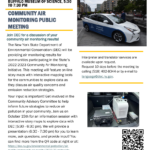 We also urge our members and supporters to join us on Tuesday October 15 from 5:30-7:30pm at the Buffalo Science Museum, 1020 Humboldt Parkway in Buffalo for NYS DEC’s Community Air Monitoring Public Meeting for our area.
We also urge our members and supporters to join us on Tuesday October 15 from 5:30-7:30pm at the Buffalo Science Museum, 1020 Humboldt Parkway in Buffalo for NYS DEC’s Community Air Monitoring Public Meeting for our area.
Basic results – Campaign Areas
Tonawandas, River Road area, and Black Rock-Riverside
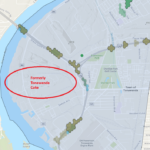 The work Clean Air has spearheaded has led to remarkable successes in our campaign areas in the Tonawandas and Black Rock-Riverside. When we began our work in the 2000s, these areas had some of the worst air pollution in the state, with benzene levels far exceeding public health standards– today is a far different story, largely due to the closure of Tonawanda Coke, NRG Huntley and the removal of the Grand Island toll booths, and the data from this study further emphasizes how important fenceline resident organizing is in achieving better public health and environmental conditions.
The work Clean Air has spearheaded has led to remarkable successes in our campaign areas in the Tonawandas and Black Rock-Riverside. When we began our work in the 2000s, these areas had some of the worst air pollution in the state, with benzene levels far exceeding public health standards– today is a far different story, largely due to the closure of Tonawanda Coke, NRG Huntley and the removal of the Grand Island toll booths, and the data from this study further emphasizes how important fenceline resident organizing is in achieving better public health and environmental conditions.
This, however, is not to say that the air pollution issues in this area are completely gone – of note, in these areas DEC’s data shows elevated levels of black carbon, PM 2.5, Nitrogen Dioxide, and Carbon Monoxide, largely along major highway corridors, like the 190 and 198. This may be from traffic, but in areas along the 190/Grand Island Boulevard in the Town of Tonawanda, this could also be from area industry – for example, oil terminals are located right next to the 190 approaching the Grand Island bridges, and a pocket of elevated black carbon and carbon monoxide has been detected in that spot. Elevated PM 2.5 in parts of the City of Tonawanda could also be carried from area industrial sources.
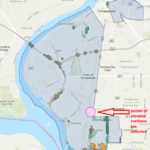
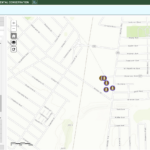 Also of note is a very elevated pocket of methane gas on Kenmore Ave near Military Road, the largest amount detected in any part of our region. This pocket could be from a leak of the gas main located near there, or could be from other nearby sources – for example, NFTA has a large bus service garage at that location, and much of the fleet runs on Compressed Natural Gas (CNG), and DEC’s InfoLocator show several capped and one uncapped well near this spot. The DEC has already begun to investigate to identify the source of this pocket of gas and eliminate the leak source.
Also of note is a very elevated pocket of methane gas on Kenmore Ave near Military Road, the largest amount detected in any part of our region. This pocket could be from a leak of the gas main located near there, or could be from other nearby sources – for example, NFTA has a large bus service garage at that location, and much of the fleet runs on Compressed Natural Gas (CNG), and DEC’s InfoLocator show several capped and one uncapped well near this spot. The DEC has already begun to investigate to identify the source of this pocket of gas and eliminate the leak source.
Buffalo East Side – Delavan-Grider, Hamlin Park and Filmore-Leroy
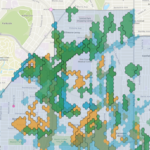 Delavan-Grider and Hamlin Park, and Filmore-Leroy are highlighted in NYS DEC’s StoryMap because of the disparate impacts these neighborhoods are bearing from industrial and automotive traffic pollution. By basically every metric, these neighborhoods are being exposed to emissions levels well above the median of the surveyed areas.
Delavan-Grider and Hamlin Park, and Filmore-Leroy are highlighted in NYS DEC’s StoryMap because of the disparate impacts these neighborhoods are bearing from industrial and automotive traffic pollution. By basically every metric, these neighborhoods are being exposed to emissions levels well above the median of the surveyed areas.
Much of this pollution appears to stem from The 33 and 198 NYS highways. As we have maintained, no matter what the final decision about whether to cap or fully remove the highway, NYS DOT MUST take public health into account and include plans for emissions mitigation – the feeble statements we have heard about how emissions will be reduced as consumers switch to electric cars or how the cap will reduce emissions in areas adjacent to it (while increasing emissions at the cap end points) are unacceptable.
The currently proposed cap plan design maintains at-grade traffic at both ends for several blocks separated from the front porch of residences by only a chain link fence, which is an unacceptable example of blatant environmental racism. Given that there will be further concentrated emissions expected in these areas (NYS DOT’s modeling predicts annual PM 2.5 of 7.5 μg/m3 under the preferred design – while this falls below the EPA’s current recommendations, for comparison, the World Health Organization suggests an annual cap of 5 5μg/m3, well below this “safe” level), and that NYS DOT’s currently preferred design does not include any plans for air quality mitigation such as vegetated sound walls for at-grade areas or stacks with scrubbers to capture emissions in the capped areas, we have to question whether NYS DOT is taking the state’s commitments to environmental justice seriously. We hope this additional data will steer NYS DOT staff to revisit designs to better address these emissions issues.
Buffalo East Side – Seneca Babcock, Lovejoy and Broadway-Fillmore
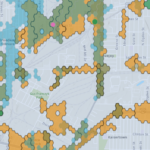 While emissions are not as concentrated in the Seneca Babcock and Lovejoy areas as in the Delavan-Grider/Hamlin Park/Filmore-Leroy areas, these neighborhoods are also grappling with disproportionately high emissions compared to other surveyed areas, particularly near Bailey Avenue and the 190. NO2 and Black Carbon in particular are elevated, and there is a concentration of high PM 2.5 near Bailey and Broadway, near our current Lovejoy campaign area. While much of this can again be attributed to automotive emissions, other emissions sources like industrial operations and the railyard are also possible culprits.
While emissions are not as concentrated in the Seneca Babcock and Lovejoy areas as in the Delavan-Grider/Hamlin Park/Filmore-Leroy areas, these neighborhoods are also grappling with disproportionately high emissions compared to other surveyed areas, particularly near Bailey Avenue and the 190. NO2 and Black Carbon in particular are elevated, and there is a concentration of high PM 2.5 near Bailey and Broadway, near our current Lovejoy campaign area. While much of this can again be attributed to automotive emissions, other emissions sources like industrial operations and the railyard are also possible culprits.
Buffalo West Side
 Buffalo’s West Side has elevated levels of NO2 and Black Carbon, mostly along the 190 and near the Peace Bridge. While we successfully fought to prevent an expansion of the Peace Bridge Plaza over a decade ago, it’s clear that more must be done by the Peace Bridge Authority and NYS DOT to address air quality issues on Buffalo’s West Side from automotive traffic. There are other possible sources of these elevated emissions, including industrial sources – further analysis is needed.
Buffalo’s West Side has elevated levels of NO2 and Black Carbon, mostly along the 190 and near the Peace Bridge. While we successfully fought to prevent an expansion of the Peace Bridge Plaza over a decade ago, it’s clear that more must be done by the Peace Bridge Authority and NYS DOT to address air quality issues on Buffalo’s West Side from automotive traffic. There are other possible sources of these elevated emissions, including industrial sources – further analysis is needed.
Basic Results – other hot spots of note
Niagara Falls
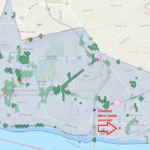 Niagara Falls has several areas of elevated emissions, particularly PM 2.5. Perhaps more alarming are the pockets of detected Hazardous Air Pollutants (HAPS) and other unique pollutants, like peak detections of Nitric Oxide just north of the LaSalle Junior High School. NYS DEC calls out the Packard Road and NYS Route 62 areas in particular in their StoryMap. If you turn on the “Sensitive Receptors” layer, you can also see how close these pollution pockets are to locations like early childhood centers, the Niagara Falls High School, and affordable housing developments.
Niagara Falls has several areas of elevated emissions, particularly PM 2.5. Perhaps more alarming are the pockets of detected Hazardous Air Pollutants (HAPS) and other unique pollutants, like peak detections of Nitric Oxide just north of the LaSalle Junior High School. NYS DEC calls out the Packard Road and NYS Route 62 areas in particular in their StoryMap. If you turn on the “Sensitive Receptors” layer, you can also see how close these pollution pockets are to locations like early childhood centers, the Niagara Falls High School, and affordable housing developments.
Over the past several years, we have been increasingly noting the ongoing air quality issues and environmental injustices in Niagara Falls – while again automotive traffic is responsible for a large amount of these emissions, poorly controlled emissions from industry in Niagara Falls is also clearly responsible for at least a portion. Clean Air is member-led and we concentrate our campaign work within our member areas. If you are a Niagara Falls resident and are interested in building a cohort of members as we grow as an organization, please reach out to Chris.
If you have any questions about the results of the Mobile Air Monitoring project, we urge you to send those questions to CLCPA.CAM@dec.ny.gov, and please consider cc’ing us at info@cacwny.org.
Please also join us on Tuesday October 15 from 5:30-7:30pm at the Buffalo Science Museum, 1020 Humboldt Parkway in Buffalo for NYS DEC’s Community Air Monitoring Public Meeting for our area and remember to fill out and share the related survey before the end of the year.
Learn More
Main DEC CAM Webpage – https://dec.ny.gov/environmental-protection/air-quality/community-air-quality/2022-23-statewide-community-air-monitoring-initiative
Buffalo Story map – https://storymaps.arcgis.com/collections/b39806cbc7ea4b139b79713720dab25f?item=4
Buffalo interactive map – https://experience.arcgis.com/experience/08b1dcca4fa24f26a77d31ac9cd1ff91/page/Buffalo/?views=Fact-Sheets
NYS DEC Press Release – https://dec.ny.gov/news/press-releases/2024/8/dec-releases-first-phase-results-of-statewide-community-air-monitoring-initiative
Buffalo News – New map Shows where air pollution is bad in Buffalo
Buffalo News Editorial Board – DEC data shows action needed on air pollution
Meet Sia Gu, our 2024 Cornell High Road Fellow!
This summer the Clean Air Coalition is a host site for the Cornell High Road Fellowship program – Sia Gu is a 2025 expected graduate who has been working with us on a number of research projects, and will be wrapping up her fellowship with us at the end of July. The following is an introduction she wrote for herself.
Dear Clean Air Members and Supporters,
Hope everyone is doing well! It’s my pleasure to introduce myself as Clean Air Coalition’s summer intern through Cornell University’s High Road Fellowship program. I am very grateful for this opportunity and look forward to working with everyone at Clean Air throughout the summer.
Growing up in Beijing, China, this summer was the first time I visited Buffalo. I’ve had an amazing time roaming through different neighborhoods, exploring new cafes with friends, and immersing myself in all that Buffalo has to offer during the summertime. I’m confident that this is the first, but not the last time, that I’ll be in Buffalo. No matter where I go after this summer, I’ll take everything I’ve learned and experienced, and will always think of returning to this beautiful city.
Interning at Clean Air has helped me recognize the environmental justice concerns lying under some of my surface-level experiences—from how a peaceful neighborhood could be right next to a polluted brownfield to factories emitting toxic waste that could go unnoticed until people fell sick. These narratives of environmental injustice—with working-class communities and people of color being disproportionately impacted by pollution—are not unfamiliar. In Beijing, as the city sprawls and expands, new construction sites never cease springing up. Dust, noise, and other health consequences are always at the back of everyone’s head but never adequately addressed. This is on top of the severe smog in 2013 that people are still recovering from. Or not even recovering, still experiencing; people who live near manufacturing facilities and cannot afford air purifiers in their homes still breathe in the oftentimes polluted air. Not to mention migrant workers and homeless people who are constantly directly exposed to air pollutants outside. I still recall a middle school field trip in 2017 when the Beijing air quality was supposedly already “fixed” and there were barely any smoggy days in the city. When we went to the suburbs and a bit further to nearby cities, we passed by large factories with black smoke floating out from the smokestacks. The air in central Beijing was improved at the cost of moving factories away from the city center to these “less important” neighborhoods. Low-income communities have no say in the air they breathe and have no one to turn to who can address the problem.
Knowing who to inform and consult is crucial when facing environmental challenges, especially when local governmental agencies fail to acknowledge the issue. Clean Air struck me with its close collaboration with Buffalo residents, its continued effort to mitigate the impact of polluting facilities, and its focus on bringing sustainable economic models for regions around Buffalo. With my prior personal and professional experiences in environmental justice, I am excited to work with Clean Air and contribute to greater Buffalo communities.
In Solidarity,
Sia Gu
High Road Fellow
Clean Air Coalition of WNY
Cindy’s Reflections on the Highlander Center’s Cultural Organizing Training
Our American Axle/Delavan-Grider Environmental Justice Organizer Cindy Stroud recently attended a training retreat on Cultural Organizing at the Highlander Center. The following are her reflections on her experience – if you a Clean Air member and are interested in this training, there is one more class planned the week of July 31 – reach out to Cindy for more info!
I arrived in Knoxville, TN, being a big girl flying all by myself, and yes, that was my first time traveling alone. I had no clue what to expect upon my arrival, but I enjoyed entering something new as an empty slate. The contact person, Oba, was there. I took a 30-minute ride and learned that the driver was also the drum instructor for Friday night. He tells me how he started in this movement, all because of his mom, an activist. We turn into an area that is nothing less than the exact design of GOD.
Beautiful, open green grass, mountains, hills, valleys, and trees for as far as the eye can see. I couldn’t believe I was here from work; wow, what will they teach me here? I was welcomed by a tall, black, beautiful woman with a clipboard. She introduced herself and then told me what door number I should look for because that was my assigned room. #12 on the door was my name: Welcome Cynthia Stroud.
After settling in and putting my belongings down, I walked around the cabin that slept 15-20 people. It is a beautiful wood cabin with a screened-in porch with about 15 rocking chairs, end tables, and board games in the corner of the porch. I felt like someone tapped into my private thoughts of my perfect place.
As people started to find their rooms, a sense of calm filled the air. Introductions were made, and the simple question ‘Where are you from?’ sparked connections.
After a few hours, everyone started to ask how we were going to get food and drinks. Do you guys drink bottled water or straight from the tap? For some reason, that was a big joke. There was some kind of mix-up with the dinner issue. We did get pizza and salad that evening, and the refrigerator had a filter on the water dispenser. By 11 p.m., with all that open land, clean air, and travel, I had to hit the hay.
Up by 6 am, I found out that a big food order had been delivered after I went to bed. In your room is a notebook with an itinerary and a number; the paper reads Wed- breakfast will be served at 9 am in the mess hall. At 10 am, everyone should meet in the round room located upstairs from the cafeteria.
We did that, then we found out what the numbers were in our notebooks; instructions were to do some research to find out what was going on that year in Highlanders, 1990 was the year I had, so we had to find out how many other people had that number also, You meet up with the group, gather all the info, and put together a presentation; we had 3 hours to work on this.
This was when I learned that Miles Horton was one of the founders of Highlanders Folk School-1930, and 1934 the first African American came to Highlander Folk School. They bring social solidarity and continue fighting for justice and equality, supporting organizing and leadership development.
But I don’t want to talk about things you can google. I want to describe my personal experience; after the first assignment, I was ready to see how they set up this entire training. The instructor’s name is Je Nae; she assured us that anything needed could be obtained.
The group talked and learned what is essential when facilitating a meeting. Who were we trying to help? What help looks like when in despair,” We are all we need.” ironically, when ever someone mentioned they were having sinus issues, a headache; someone in the room always had something with them to help,” we all we need was reiterate, which left me feeling that I didn’t have to be the person in charge, the one everyone looks to to solve whatever issues that have arisen and make it better.
I’ve been that person for so long; it’s so lovely when you can allow others to play their role.
We were instructed to close our eyes and think of someone in our family that you never met but they are no longer with us. I did what was asked and thought and reflected on pictures and the few stories that I heard about her- y grandmother that I never met, Molly. I still can’t explain what happened, but I can tell you that was the first of many meditation sessions just focusing on my ancestors.
The people that I met were amazing. Most of them lived in the south; a few of the young ladies were Doulas. We talked about having babies and all the ways childbearing has changed. My experience comes from life, theirs mostly from a books—that’s one of the things I enjoy about being a Seasoned woman. The lessons that I have lived I’ll never forget. GOLD!
After lunch, we did a different exercise; all we had to do was find a partner, introduce ourselves, and ask the person ten x’s who are you. Then tell the person what the relationship between you and the deceased person was, from the am session.
It sounds pretty simple; well, by the 5th, who are you? I was in tears. Hearing you say the affirmation was powerful, a MOM, a SISTER, AUNT, HELPER, a NEIGHBOR, an activist GRANDMOTHER a EXWIFE, I was not the only one; the room was filled with open, raw emotions, people sobbing with this belief that the question opened their eyes to hear you are a lot, you are the help I need. I felt vulnerable, open, and ready to learn more.
The next two days were spent learning how effective protest are, when coming together chants and, how they stay in your head, the power that they possess. I could only imagine how Martin Luther King and Rosa Parks felt being at Highlanders with like minded people believing in the movement.
I am a true believer that everything happens for a reason; at this time of my life going to Highlanders was an answered prayer that I didn’t even ask for. I needed this more than I knew, I was at a point in my life where I needed to redefine who I was, and I didn’t quite know how to do it this time; Highlanders reassured me that Clean Air is precisely where I’m supposed to be helping the community, and trying to build grassroots leaders.
I experienced early morning meditations, being able to think, not hearing the inner city sounds, it was like not being in the real world for a few days. I was unavailable to the world. It’s been forever since I have stepped away from my world. I experienced a sound bath; by this time I am allowing my mind, body & spirit to be open, free and non judgmental.
I closed my eyes, listened to the sounds and felt like I was transported to a place of calmness, acceptance, and healing.
This is how people get in tune with mother earth and their inner being. I felt my third eye being wide open, it woke up something in me – it’s time to step into what you’re going to be doing for the next 10 years and I’m sure I’ll be doing this work until I die. I love it.
We learned about the Triad or triangle, what it means, how it helps us to stay focused on the problem, people and targets. People don’t plan to fail; they fail to plan.
Knowledge is the key understanding, making sure everyone is on the same page- we will make sure that we are all ok.
We learned songs and learned to listen to the messages in the music; it was a cultural teaching that I was so glad to be getting. We were privileged to learn about an Altar and welcomed to place things on the altar and offer sacrifices; it made me feel like I was acknowledging my memories.
I learned from one of the facilitators when you stand before a group of people that you may be a little nervous to speak in front of, stand, take a deep breath, and with your hands beside you, palms to the back. You stand and allow your accessories to support you to stand behind you and give you that support that only something in you knows how to help, hold, reassure you that, we got this.
It’s the You that is in you that supports, loves and protects you, that allows you to become a better you. Believe in you.
Friday is the last day of coming together, working in groups to strategize, acknowledge the targets, help the oppressed, and show people that we are worth speaking up for and fighting for.
People are power; we must be reminded.
We did a compelling presentation on different subjects; my group worked on Seeds; the idea was to draw a picture of a seed on a pregnant woman’s belly, to show how a human (seed) is growing. The group talked about the entire family unit, how to impact the unit, what is needed to assist the male, encourage him to learn to farm, and how to be a helper in the unit; everyone plays a vital part in a family.
After dinner, we had a three-hour break and needed to meet at 8 for the drum lesson. 8pm- in a big circle were bongos and chairs; we sat and tried to mimic what the instructor played, 1-2 -1-2 1-2.
After a while, everyone hitting the drums sounded like folk music to me—seeing a group of 15 people coming together on Wednesday as strangers, we were nothing less than a chosen family by Friday. It was wonderful, food for the soul.
It’s Friday, and we are Kindreds now. I felt as if the universe replaced people I had lost in the past ten years with new people. Who am I? I don’t deserve more souls to love; I guess I do because I have them now.
Then, the frosting on the cake happened when the skies opened up, and a vibrant burst of majestic pink fuchsia and purple exploded in the sky, making what looked like a neon rainbow. It was the Northern Lights, which could only be seen in Knoxville, Tennessee, and Buffalo, New York (it was all for me). That was my experience at Highlander’s magical trip for a GOLD lady ME.
Almost 90% of Title V Air Permits in Erie and Niagara County are Expired – Buffalo News Coverage
As we have been openly stating for almost a year now, NYS DEC has a significant backlog of Title V air permits and other permits that has developed over time since the staffing and program funding freezes and cuts that Governor Cuomo put in place at state agencies in response to the 2008 Financial Crisis. We began learning of this problem as we examined the Title V permit for the Fortistar power plant in North Tonawanda, and were shocked to see permits for sites like 3M in the River Road corridor with permits that expired over a decade ago. NYS Comptroller DiNapoli released an in-depth report in September 2023 specifically about the backlogged air permit reviews.
An expired permit does not necessarily mean dangerous levels of emissions from these sources – but it is a red alert that our regulatory agencies are not staffed to sufficient levels to protect the public and that there are gaps in our oversight capacity. Further, it means that permits that these sites are operating under were written under older environmental laws – earlier this year, for example, the EPA strengthened the rules about PM 2.5 safety thresholds, and older permits were written for the older threshold.
We are also alarmed by the slow tick upward in reported emissions at some of these facilities – while still operating within the parameters set by their older permits, at least to the best of our knowledge, it’s very worrying to see these increases, especially in Hazardous Air Pollutants (HAPS), Volatile Organic Compounds (VOCs), and greenhouse gas emissions like CO2. Not only does that put public health at increased risk, all of these increases also threaten to undermine the actions that we’re all taking to reduce and ultimately eliminate our statewide impacts on climate change, like transitioning away from the use of gas in our homes.
The Buffalo News this past Sunday featured deep dive coverage on the statewide issue of expired Title V permits, including the almost 90% of expired Title Vs in Erie and Niagara counties – click here to read the coverage!
Yesterday the Editorial Board also featured commentary further called on our representatives in Albany to take immediate steps to address the backlog, whether that’s NYS DEC prioritizing the reviews, our State Legislature passing environmental bills like S9370 which would mandate that permit reviews be completed within 5 years of expiration, or Governor Hochul taking the lead to steer these actions and develop a plan to address systemic understaffing at our state agencies. Click here to read the editorial!
Want to take action to pressure our representatives to take these steps? Join us on Wednesday July 24 for our next General Meeting to learn about what we are currently doing, and to talk with peers about how you’d like to get involved or what you’d like to take leadership on!
